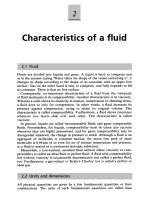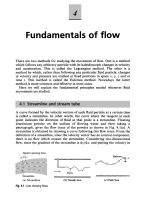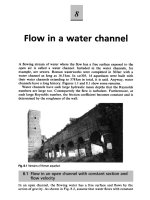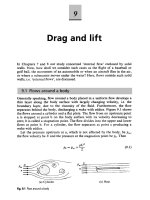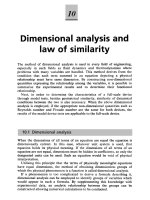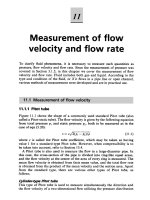fluid mechanics, fourth edition
Bạn đang xem bản rút gọn của tài liệu. Xem và tải ngay bản đầy đủ của tài liệu tại đây (9.21 MB, 901 trang )
Fluid Mechanics, Fourth Edition
Founders of Modern Fluid Dynamics
Ludwig Prandtl G. I. Taylor
(1875–1953) (1886–1975)
(Biographical sketches of Prandtl and Taylor are given in Appendix C.)
Photograph of Ludwig Prandtl is reprinted with permission from the Annual Review of Fluid
Mechanics, Vol. 19, Copyright 1987 by Annual Reviews www.AnnualReviews.org.
Photograph of Geoffrey Ingram Taylor at age 69 in his laboratory reprinted with permission
from the AIP Emilio Segr
`
e Visual Archieves. Copyright, American Institute of Physics, 2000.
Fluid Mechanics
Fourth Edition
Pijush K. Kundu
Oceanographic Center
Nova Southeastern University
Dania, Florida
Ira M. Cohen
Department of Mechanical Engineering and
Applied Mechanics
University of Pennsylvania
Philadelphia, Pennsylvania
with contributions by P. S. Ayyaswamy and H. H. Hu
AMSTERDAM
•
BOSTON
•
HEIDELBERG
•
LONDON
NEW YORK
•
OXFORD
•
PARIS
•
SAN DIEGO
Academic Press is an imprint of Elsevier
SAN FRANCISCO
•
•
SINGAPORE
•
TOKYOSYDNEY
Academic Press is an imprint of Elsevier
30 Corporate Drive, Suite 400
Burlington, MA 01803, USA
Elsevier, The Boulevard, Langford Lane
Kidlington, Oxford, OX5 1GB, UK
© 2008 Elsevier Inc. All rights reserved.
No part of this publication may be reproduced or transmitted in any form or by any means, electronic or
mechanical, including photocopying, recording, or any information storage and retrieval system, without
permission in writing from the publisher. Details on how to seek permission, further information about the
Publisher’s permissions policies and our arrangements with organizations such as the Copyright Clearance
Center and the Copyright Licensing Agency, can be found at our website: www.elsevier.com/permissions.
This book and the individual contributions contained in it are protected under copyright by the
Publisher (other than as may be noted herein).
Notices
Knowledge and best practice in this field are constantly changing. As new research and experience
broaden our understanding, changes in research methods, professional practices, or medical treatment may
become necessary.
Practitioners and researchers must always rely on their own experience and knowledge in evaluating
and using any information, methods, compounds, or experiments described herein. In using such
information or methods they should be mindful of their own safety and the safety of others, including
parties for whom they have a professional responsibility.
To the fullest extent of the law, neither the Publisher nor the authors, contributors, or editors, assume
any liability for any injury and/or damage to persons or property as a matter of products liability,
negligence or otherwise, or from any use or operation of any methods, products, instructions, or ideas
contained in the material herein.
Library of Congress Cataloging-in-Publication Data
Kundu, Pijush K.
Fluid mechanics / Pijush K. Kundu, Ira M. Cohen. – 4th ed.
p. cm.
Includes bibliographical references and index.
ISBN 978-0-12-373735-9 (alk. paper) /
1. Fluid mechanics. I. Cohen, Ira M. II. Title.
QA901.K86 2008
620.1’06–dc22 2007042765
Reprinted January 2010 – ISBN: 978-0-12-381399-2
British Library Cataloguing-in-Publication Data
A catalogue record for this book is available from the British Library.
For information on all Academic Press publications
visit our Web site at www.elsevierdirect.com
Printed in the United States
10 11 12 13 14 10 9 8 7 6 5 4 3 2 1
The fourth edition is dedicated to the memory of Pijush K. Kundu and also to my
wife Linda and daughters Susan and Nancy who have greatly enriched my life.
“Everything should be made as simple as possible,
but not simpler.”
—Albert Einstein
“If nature were not beautiful, it would not be worth studying it.
And life would not be worth living.”
—Henry Poincar
´
e
In memory of Pijush Kundu
Pijush Kanti Kundu was born in Calcutta,
India, on October 31, 1941. He received a
B.S. degree in Mechanical Engineering in
1963 from Shibpur Engineering College of
Calcutta University, earned an M.S. degree
in Engineering from Roorkee University in
1965, and was a lecturer in Mechanical Engi-
neering at the Indian Institute of Technology
in Delhi from 1965 to 1968. Pijush came to
the United States in 1968, as a doctoral stu-
dent at Penn State University. With Dr. John
L. Lumley as his advisor, he studied instabili-
ties ofviscoelastic fluids,receiving his doctor-
ate in 1972. He began his lifelong interest in
oceanography soon after his graduation, working as Research Associate in Oceano-
graphy at Oregon State University from 1968 until 1972. After spending a year at
the University de Oriente in Venezuela, he joined the faculty of the Oceanographic
Center of Nova Southeastern University, where he remained until his death in 1994.
During his career, Pijush contributed to a number of sub-disciplines in physical
oceanography, most notably in the fields of coastal dynamics, mixed-layer physics,
internal waves, and Indian-Ocean dynamics. He was a skilled data analyst, and, in
this regard, one of his accomplishments was to introduce the “empirical orthogonal
eigenfunction” statistical technique to the oceanographic community.
I arrived at Nova Southeastern University shortly after Pijush, and heand Iworked
closely together thereafter. I was immediately impressed with the clarity of his scien-
tific thinking and his thoroughness. His most impressive and obvious quality, though,
was his love of science, which pervaded all his activities. Some time after we met,
Pijush opened a drawer in a desk in his home office, showing me drafts of several
chapters to a book he had always wanted to write. A decade later, this manuscript
became the first edition of “Fluid Mechanics,” the culmination of his lifelong dream;
which he dedicated to the memory of his mother, and to his wife Shikha, daughter
Tonushree, and son Joydip.
Julian P. McCreary, Jr.,
University of Hawaii
Contents
Preface xvii
Preface to Third Edition xix
Preface to Second Edition xxi
Preface to First Edition xxiii
Author’s Notes xxvii
Chapter 1
Introduction
1. Fluid Mechanics 1
2. Units of Measurement 2
3. Solids, Liquids, and Gases 3
4. Continuum Hypothesis 4
5. Transport Phenomena 5
6. Surface Tension 8
7. Fluid Statics 9
8. Classical Thermodynamics 12
9. Perfect Gas 16
10. Static Equilibrium of a Compressible Medium 18
Exercises 22
Literature Cited 24
Supplemental Reading 24
Chapter 2
Cartesian Tensors
1. Scalars and Vectors 25
2. Rotation of Axes: Formal Definition of a Vector 26
3. Multiplication of Matrices 29
4. Second-Order Tensor 30
5. Contraction and Multiplication 32
vii
New in This Book
xvi
viii Contents
6. Force on a Surface 33
7. Kronecker Delta and Alternating Tensor 36
8. Dot Product 37
9. Cross Product 38
10. Operator ∇: Gradient, Divergence, and Curl 38
11. Symmetric and Antisymmetric Tensors 40
12. Eigenvalues and Eigenvectors of a Symmetric Tensor 41
13. Gauss’ Theorem 44
14. Stokes’ Theorem 47
15. Comma Notation 49
16. Boldface vs Indicial Notation 49
Exercises 50
Literature Cited 51
Supplemental Reading 51
Chapter 3
Kinematics
1. Introduction 53
2. Lagrangian and Eulerian Specifications 54
3. Eulerian and Lagrangian Descriptions: The Particle Derivative 55
4. Streamline, Path Line, and Streak Line 57
5. Reference Frame and Streamline Pattern 59
6. Linear Strain Rate 60
7. Shear Strain Rate 61
8. Vorticity and Circulation 62
9. Relative Motion near a Point: Principal Axes 64
10. Kinematic Considerations of Parallel Shear Flows 67
11. Kinematic Considerations of Vortex Flows 68
12. One-, Two-, and Three-Dimensional Flows 71
13. The Streamfunction 73
14. Polar Coordinates 75
Exercises 77
Supplemental Reading 79
Chapter 4
Conservation Laws
1. Introduction 82
2. Time Derivatives of Volume Integrals 82
3. Conservation of Mass 84
4. Streamfunctions: Revisited and Generalized 87
5. Origin of Forces in Fluid 88
6. Stress at a Point 90
Contents ix
7. Conservation of Momentum 92
8. Momentum Principle for a Fixed Volume 93
9. Angular Momentum Principle for a Fixed Volume 98
10. Constitutive Equation for Newtonian Fluid 100
11. Navier–Stokes Equation 104
12. Rotating Frame 105
13. Mechanical Energy Equation 111
14. First Law of Thermodynamics: Thermal Energy Equation 115
15. Second Law of Thermodynamics: Entropy Production 116
16. Bernoulli Equation 118
17. Applications of Bernoulli’s Equation 122
18. Boussinesq Approximation 124
19. Boundary Conditions 129
Exercises 134
Literature Cited 136
Supplemental Reading 137
Chapter 5
Vorticity Dynamics
1. Introduction 139
2. Vortex Lines and Vortex Tubes 140
3. Role of Viscosity in Rotational and Irrotational Vortices 141
4. Kelvin’s Circulation Theorem 144
5. Vorticity Equation in a Nonrotating Frame 149
6. Velocity Induced by a Vortex Filament: Law of Biot and Savart 151
7. Vorticity Equation in a Rotating Frame 152
8. Interaction of Vortices 157
9. Vortex Sheet 161
Exercises 161
Literature Cited 163
Supplemental Reading 163
Chapter 6
Irrotational Flow
1. Relevance of Irrotational Flow Theory 165
2. Velocity Potential: Laplace Equation 167
3. Application of Complex Variables 169
4. Flow at a Wall Angle 171
5. Sources and Sinks 173
6. Irrotational Vortex 174
7. Doublet 174
8. Flow past a Half-Body 175
x Contents
9. Flow past a Circular Cylinder without Circulation 178
10. Flow past a Circular Cylinder with Circulation 180
11. Forces on a Two-Dimensional Body 184
12. Source near a Wall: Method of Images 189
13. Conformal Mapping 190
14. Flow around an Elliptic Cylinder with Circulation 192
15. Uniqueness of Irrotational Flows 194
16. Numerical Solution of Plane Irrotational Flow 195
17. Axisymmetric Irrotational Flow 201
18. Streamfunction and Velocity Potential for Axisymmetric Flow 203
19. Simple Examples of Axisymmetric Flows 205
20. Flow around a Streamlined Body of Revolution 206
21. Flow around an Arbitrary Body of Revolution 208
22. Concluding Remarks 209
Exercises 209
Literature Cited 212
Supplemental Reading 212
Chapter 7
Gravity Waves
1. Introduction 214
2. The Wave Equation 214
3. Wave Parameters 216
4. Surface Gravity Waves 219
5. Some Features of Surface Gravity Waves 223
6. Approximations for Deep and Shallow Water 229
7. Influence of Surface Tension 234
8. Standing Waves 237
9. Group Velocity and Energy Flux 238
10. Group Velocity and Wave Dispersion 242
11. Nonlinear Steepening in a Nondispersive Medium 246
12. Hydraulic Jump 248
13. Finite Amplitude Waves of Unchanging Form in a
Dispersive Medium 250
14. Stokes’ Drift 253
15. Waves at a Density Interface between Infinitely Deep Fluids 255
16. Waves in a Finite Layer Overlying an Infinitely Deep Fluid 259
17. Shallow Layer Overlying an Infinitely Deep Fluid 262
18. Equations of Motion for a Continuously Stratified Fluid 263
19. Internal Waves in a Continuously Stratified Fluid 267
20. Dispersion of Internal Waves in a Stratified Fluid 270
21. Energy Considerations of Internal Waves in a Stratified Fluid 272
Exercises 276
Literature Cited 277
Contents xi
Chapter 8
Dynamic Similarity
1. Introduction 279
2. Nondimensional Parameters Determined from Differential
Equations 280
3. Dimensional Matrix 284
4. Buckingham’s Pi Theorem 285
5. Nondimensional Parameters and Dynamic Similarity 287
6. Comments on Model Testing 290
7. Significance of Common Nondimensional Parameters 292
Exercises 294
Literature Cited 294
Supplemental Reading 294
Chapter 9
Laminar Flow
1. Introduction 295
2. Analogy between Heat and Vorticity Diffusion 297
3. Pressure Change Due to Dynamic Effects 297
4. Steady Flow between Parallel Plates 298
5. Steady Flow in a Pipe 302
6. Steady Flow between Concentric Cylinders 303
7. Impulsively Started Plate: Similarity Solutions 306
8. Diffusion of a Vortex Sheet 313
9. Decay of a Line Vortex 315
10. Flow Due to an Oscillating Plate 317
11. High and Low Reynolds Number Flows 320
12. Creeping Flow around a Sphere 322
13. Nonuniformity of Stokes’ Solution and Oseen’s Improvement 327
14. Hele-Shaw Flow 332
15. Final Remarks 334
Exercises 335
Literature Cited 337
Supplemental Reading 337
Chapter 10
Boundary Layers and Related Topics
1. Introduction 340
2. Boundary Layer Approximation 340
3. Different Measures of Boundary Layer Thickness 346
4. Boundary Layer on a Flat Plate with a Sink at the Leading Edge:
Closed Form Solution 348
xii Contents
5. Boundary Layer on a Flat Plate: Blasius Solution 352
6. von Karman Momentum Integral 362
7. Effect of Pressure Gradient 364
8. Separation 366
9. Description of Flow past a Circular Cylinder 368
10. Description of Flow past a Sphere 375
11. Dynamics of Sports Balls 376
12. Two-Dimensional Jets 381
13. Secondary Flows 388
14. Perturbation Techniques 389
15. An Example of a Regular Perturbation Problem 394
16. An Example of a Singular Perturbation Problem 396
17. Decay of a Laminar Shear Layer 401
Exercises 407
Literature Cited 409
Supplemental Reading 410
Chapter 11
Computational Fluid Dynamics
1. Introduction 411
2. Finite Difference Method 413
3. Finite Element Method 418
4. Incompressible Viscous Fluid Flow 426
5. Three Examples 440
6. Concluding Remarks 461
Exercises 463
Literature Cited 464
Chapter 12
Instability
1. Introduction 467
2. Method of Normal Modes 469
3. Thermal Instability: The B
´
enard Problem 470
4. Double-Diffusive Instability 482
5. Centrifugal Instability: Taylor Problem 486
6. Kelvin–Helmholtz Instability 493
7. Instability of Continuously Stratified Parallel Flows 500
8. Squire’s Theorem and Orr–Sommerfeld Equation 507
9. Inviscid Stability of Parallel Flows 510
10. Some Results of Parallel Viscous Flows 514
11. Experimental Verification of Boundary Layer Instability 520
12. Comments on Nonlinear Effects 522
Contents xiii
13. Transition 523
14. Deterministic Chaos 525
Exercises 533
Literature Cited 535
Chapter 13
Turbulence
1. Introduction 537
2. Historical Notes 539
3. Averages 541
4. Correlations and Spectra 543
5. Averaged Equations of Motion 547
6. Kinetic Energy Budget of Mean Flow 554
7. Kinetic Energy Budget of Turbulent Flow 556
8. Turbulence Production and Cascade 559
9. Spectrum of Turbulence in Inertial Subrange 562
10. Wall-Free Shear Flow 564
11. Wall-Bounded Shear Flow 570
12. Eddy Viscosity and Mixing Length 580
13. Coherent Structures in a Wall Layer 584
14. Turbulence in a Stratified Medium 586
15. Taylor’s Theory of Turbulent Dispersion 591
16. Concluding Remarks 598
Exercises 598
Literature Cited 600
Supplemental Reading 601
Chapter 14
Geophysical Fluid Dynamics
1. Introduction 603
2. Vertical Variation of Density in Atmosphere and Ocean 605
3. Equations of Motion 607
4. Approximate Equations for a Thin Layer on a Rotating Sphere 610
5. Geostrophic Flow 613
6. Ekman Layer at a Free Surface 617
7. Ekman Layer on a Rigid Surface 622
8. Shallow-Water Equations 625
9. Normal Modes in a Continuously Stratified Layer 628
10. High- and Low-Frequency Regimes in Shallow-Water
Equations 634
11. Gravity Waves with Rotation 636
12. Kelvin Wave 639
xiv Contents
13. Potential Vorticity Conservation in Shallow-Water
Theory 644
14. Internal Waves 647
15. Rossby Wave 657
16. Barotropic Instability 663
17. Baroclinic Instability 665
18. Geostrophic Turbulence 673
Exercises 676
Literature Cited 677
Chapter 15
Aerodynamics
1. Introduction 679
2. The Aircraft and Its Controls 680
3. Airfoil Geometry 683
4. Forces on an Airfoil 684
5. Kutta Condition 684
6. Generation of Circulation 687
7. Conformal Transformation for Generating Airfoil Shape 688
8. Lift of Zhukhovsky Airfoil 692
9. Wing of Finite Span 695
10. Lifting Line Theory of Prandtl and Lanchester 697
11. Results for Elliptic Circulation Distribution 701
12. Lift and Drag Characteristics of Airfoils 704
13. Propulsive Mechanisms of Fish and Birds 706
14. Sailing against the Wind 708
Exercises 709
Literature Cited 711
Supplemental Reading 711
Chapter 16
Compressible Flow
1. Introduction 713
2. Speed of Sound 717
3. Basic Equations for One-Dimensional Flow 721
4. Stagnation and Sonic Properties 724
5. Area–Velocity Relations in One-Dimensional Isentropic Flow 729
6. Normal Shock Wave 733
7. Operation of Nozzles at Different Back Pressures 741
8. Effects of Friction and Heating in Constant-Area Ducts 747
9. Mach Cone 750
10. Oblique Shock Wave 752
11. Expansion and Compression in Supersonic Flow 756
Contents xv
12. Thin Airfoil Theory in Supersonic Flow 758
Exercises 761
Literature Cited 763
Supplemental Reading 763
Chapter 17
Introduction to Biofluid Mechanics
1. Introduction 765
2. The Circulatory System in the Human Body 766
3. Modelling of Flow in Blood Vessels 782
4. Introduction to the Fluid Mechanics of Plants 831
Exercises 837
Acknowledgment 838
Literature Cited 838
Appendix A
Some Properties of Common Fluids
A1. Useful Conversion Factors 841
A2. Properties of Pure Water at Atmospheric Pressure 842
A3. Properties of Dry Air at Atmospheric Pressure 842
A4. Properties of Standard Atmosphere 843
Appendix B
Curvilinear Coordinates
B1. Cylindrical Polar Coordinates 845
B2. Plane Polar Coordinates 847
B3. Spherical Polar Coordinates 847
Appendix C
Founders of Modern Fluid Dynamics
Ludwig Prandtl (1875–1953) 851
Geoffrey Ingram Taylor (1886–1975) 852
Supplemental Reading 853
Appendix D
Visual Resources 855
Index 857
New in This Book
We are pleased to include a free copy of the DVD Multimedia Fluid Mechanics,
2/e, with this copy of Fluid Mechanics, Fourth Edition
.
You will find it in a
p
lastic
sleeve on the inside back cover of the book. If you are purchasing a used copy, be
aware that the DVD might have been removed by a previous owner.
Additional new features:
xvi
Inspired by the reception of the first edition, the objectives in Multimedia
Fluid
M
echanics
,
2/e, remain to exploit the moving image and interactivity of multi
–
media to improve the teaching and learning of fluid mechanics in all disciplines by
illustrating fundamental phenomena and conveying fascinating fluid flows fo
r
generations to come.
The completely new edition on the DVD includes the following:
• Twice the coverage with new modules on turbulence, control volumes,
interfacial phenomena, and similarity and scaling
• Four times the number of fluids videos, now more than 800
• Now more than 20 Virtual labs and simulations
• Dozens of new interactive demonstrations and animations
• Improved navigation via side bars that provide rapid overviews of
modules and guided browsing
• Media libraries for each chapter that give a snapshot of videos, each with
descriptive labels
• Ability to create movie playlists, which are invaluable in teaching
• Higher-resolution graphics, with full or part screen viewing options
• Operates on either a PC or a Mac OSX
Preface
Fluid mechanics has a vast scope and touches every aspect of our lives. Just look at
the contents of the 39 volumes of the Annual Review of Fluid Mechanics (1969–2007)
for validation of that statement. We cover only a tiny fraction of that scope in this
book.
This Fourth Edition continues to evolve due to the kindness of readers and users
who write to me suggesting corrections. Specifically, Roger Berlind of Columbia
University is responsible for the revisions to the Thermal Wind subsection of
Chapter 14. Howard Hu has revised, streamlined, and updated his chapter on Com-
putational Fluid Dynamics, and P. S. Ayyaswamy has contributed a new chapter (17)
on Introduction to Biofluid Mechanics. It is an excellently written contribution
and unique in that its level is appropriate for this book. It is between the advanced
treatises and overly simplified treatments available elsewhere. I have tried to update
much of the remaining material, particularly on turbulence, where so many new
papers appear each year. Reference to the collection of the National Committee for
Fluid Mechanics Films, now available for viewing via the Internet, is made in a new
Appendix D. These films may be old but remain an excellent resource for visualization
of flows.
On a more personal note, the bladder cancer (transitional cell carcinoma) diag-
nosed in the Fall of 2003, and attacked by a sequence of surgeries and a regimen of
chemotherapy, was never completely killed and grew back to visibility in the Fall
of 2006. The minimum visible spot on MRI can contain 70,000 TCC. A new and
harsher regimen of chemotherapy was prescribed through the Spring of 2007, during
the period when the updates were prepared. The irony of the fact that all the chemical
poisons infused into my veins are fluids is not lost on me. Because of the fatigue,
I accomplished less than I had hoped. Since radiologists cannot distinguish viable
living TCC from those that have been killed and remain in place, the only means of
discerning living cancer is to image again and see if there is new growth. The image
in early June confirmed the message that my body had already sent me: the cancer
was growing back and causing pain. Radiation was tried for a while to shrink the
painful tumor but that was unsuccessful. In late July a new regimen of chemotherapy
began, to last perhaps through the end of the year and beyond. The initial response
was positive and, although I have come to realize that my condition is incurable, I was
ever hopeful. After three infusions, however, the toxic effects of the chemotherapy
were more destructive than the aggressiveness of the cancer. I was left with no lung
capacity, no muscle strength, and was very ill and weak when page proofs came back
for checking. I remain so at the time of this writing.
xvii
xviii Preface
I appreciate all the help provided by Ms. Susan Waddington in the preparation
of the final stages of this manuscript.
I am very grateful to my family, friends, and colleagues for their support through-
out this ordeal.
Ira M. Cohen
Preface to Third Edition
This edition provided me with the opportunity to include (almost) all of the additional
material I had intended for the Second Edition but had to sacrifice because of the
crush of time. It also provided me with an opportunity to rewrite and improve the
presentation of material on jets in Chapter 10. In addition, Professor Howard Hu
greatly expanded his CFD chapter. The expansion of the treatment of surface tension
is due to the urging of Professor E. F. “Charlie” Hasselbrink of the University of
Michigan.
I am grateful to Mr. Karthik Mukundakrishnan for computations of boundary
layer problems, to Mr. Andrew Perrin for numerous suggestions for improvement
and some computations, and to Mr. Din-Chih Hwang for sharing his latest results
on the decay of a laminar shear layer. The expertise of Ms. Maryeileen Banford in
preparing new figures was invaluable and is especially appreciated.
The page proofs of the text were read between my second and third surgeries
for stage 3 bladder cancer. The book is scheduled to be released in the middle of my
regimen of chemotherapy. My family, especially my wife Linda and two daughters
(both of whom are cancer survivors), have been immensely supportive during this
very difficult time. I am also very grateful for the comfort provided by my many
colleagues and friends.
Ira M. Cohen
xix
This page intentionally left blank
Preface to Second Edition
My involvement with Pijush Kundu’s Fluid Mechanics first began in April 1991 with
a letter from him asking me to consider his book for adoption in the first year graduate
course I had been teaching for 25 years. That started a correspondence and, in fact,
I did adopt the book for the following academic year. The correspondence related
to improving the book by enhancing or clarifying various points. I would not have
taken the time to do that if I hadn’t thought this was the best book at the first-year
graduate level. By the end of that year we were already discussing a second edition
and whether I would have a role in it. By early 1992, however, it was clear that I
had a crushing administrative burden at the University of Pennsylvania and could not
undertake any time-consuming projects for the next several years. My wife and I met
Pijush and Shikha for the first time in December 1992. They were a charming, erudite,
sophisticated couple with two brilliant children. We immediately felt a bond of warmth
and friendship with them. Shikha was a teacher like my wife so the four of us had a
great deal in common. A couple of years later we were shocked to hear that Pijush had
died suddenly and unexpectedly. It saddened me greatly because I had been looking
forward to working with Pijush on the second edition after my term as department
chairman ended in mid-1997. For the next year and a half, however, serious family
health problems detoured any plans. Discussions on this edition resumed in July of
1999 and were concluded in the Spring of 2000 when my work really started. This
book remains the principal work product of Pijush K. Kundu, especially the lengthy
chapters on Gravity Waves, Instability, and Geophysical Fluid Dynamics, his areas of
expertise. I have added new material to all of the other chapters, often providing an
alternative point of view. Specifically, vector field derivatives have been generalized,
as have been streamfunctions. Additional material has been added to the chapters on
laminar flows and boundary layers. The treatment of one-dimensional gasdynamics
has been extended. More problems have been added to most chapters. Professor
Howard H. Hu, a recognized expert in computational fluid dynamics, graciously
provided an entirely new chapter, Chapter 11, thereby providing the student with an
entree into this exploding new field. Both finite difference and finite element methods
are introduced and a detailed worked-out example of each is provided.
I have been a student of fluid mechanics since 1954 when I entered college to
study aeronautical engineering. I have been teaching fluid mechanics since 1963 when
I joined the Brown University faculty, and I have been teaching a course corresponding
to this book since moving to the University of Pennsylvania in 1966. I am most grateful
to two of my own teachers, Professor Wallace D. Hayes (1918–2001), who expressed
fluid mechanics in the clearest way I have ever seen, and Professor Martin D. Kruskal,
whose use of mathematics to solve difficult physical problems was developed to a
xxi
xxii Preface to Second Edition
high art form and reminds me of a Vivaldi trumpet concerto. His codification of rules
of applied limit processes into the principles of “Asymptotology” remains with me
today as a way to view problems. I am grateful also to countless students who asked
questions, forcing me to rethink many points.
The editors at Academic Press, Gregory Franklin and Marsha Filion (assistant)
have been very supportive of my efforts and have tried to light a fire under me. Since
this edition was completed, I found that there is even more new and original material
I would like to add. But, alas, that will have to wait for the next edition. The new figures
and modifications of old figures were done by Maryeileen Banford with occasional
assistance from the school’s software expert, Paul W. Shaffer. I greatly appreciate
their job well done.
Ira M. Cohen
Preface to First Edition
This book is a basic introduction to the subject of fluid mechanics and is intended for
undergraduate and beginning graduate students of science and engineering. There is
enough material in the book for at least two courses. No previous knowledge of the
subject is assumed, and much of the text is suitable in a first course on the subject. On
the other hand, a selection of the advanced topics could be used in a second course.
I have not tried to indicate which sections should be considered advanced; the choice
often depends on the teacher, the university, and the field of study. Particular effort
has been made to make the presentation clear and accurate and at the same time easy
enough for students. Mathematically rigorous approaches have been avoided in favor
of the physically revealing ones.
A survey of the available texts revealed the need for a book with a balanced
view, dealing with currently relevant topics, and at the same time easy enough for
students. The available texts can perhaps be divided into three broad groups. One
type, written primarily for applied mathematicians, deals mostly with classical topics
such as irrotational and laminar flows, in which analytical solutions are possible.
A second group of books emphasizes engineering applications, concentrating on
flows in such systems as ducts, open channels, and airfoils. A third type of text is
narrowly focused toward applications to large-scale geophysical systems, omitting
small-scale processes which are equally applicable to geophysical systems as well as
laboratory-scale phenomena. Several of these geophysical fluid dynamics texts are
also written primarily for researchers and are therefore rather difficult for students.
I have tried to adopt a balanced view and to deal in a simple way with the basic ideas
relevant to both engineering and geophysical fluid dynamics.
However, I have taken a rather cautious attitude toward mixing engineering and
geophysical fluid dynamics, generally separating them in different chapters. Although
the basic principles are the same, the large-scale geophysical flows are so dominated
by the effects of the Coriolis force that their characteristics can be quite different
from those of laboratory-scale flows. It is for this reason that most effects of planetary
rotation are discussed in a separate chapter, although the concept of the Coriolis force
is introduced earlier in the book. The effects of density stratification, on the other hand,
are discussed in several chapters, since they can be important in both geophysical and
laboratory-scale flows.
The choice of material is always a personal one. In my effort to select topics,
however, I have been careful not to be guided strongly by my own research interests.
The material selected is what I believe to be of the most interest in a book on general
fluid mechanics. It includes topics of special interest to geophysicists (for example,
the chapters on Gravity Waves and Geophysical Fluid Dynamics) and to engineers
xxiii
xxiv Preface to First Edition
(for example, the chapters on Aerodynamics and Compressible Flow). There are also
chapters of common interest, such as the first five chapters, and those on Boundary
Layers, Instability, and Turbulence. Some of the material is now available only in
specialized monographs; such material is presented here in simple form, perhaps
sacrificing some formal mathematical rigor.
Throughout the book the convenience of tensor algebra has been exploited freely.
My experience is that many students feel uncomfortable with tensor notation in the
beginning, especially with the permutation symbol ε
ijk
. After a while, however, they
like it. In any case, following an introductory chapter, the second chapter of the book
explains the fundamentals of Cartesian Tensors. The next three chapters deal with
standard and introductory material on Kinematics, Conservation Laws, and Vorticity
Dynamics. Most of the material here is suitable for presentation to geophysicists as
well as engineers.
In much of the rest of the book the teacher is expected to select topics that are
suitable for his or her particular audience. Chapter 6 discusses Irrotational Flow; this
material is rather classical but is still useful for two reasons. First, some of the results
are used in later chapters, especially the one on Aerodynamics. Second, most of the
ideas are applicable in the study of other potential fields, such as heat conduction
and electrostatics. Chapter 7 discusses Gravity Waves in homogeneous and stratified
fluids; the emphasis is on linear analysis, although brief discussions of nonlinear
effects such as hydraulic jump, Stokes’s drift, and soliton are given.
After a discussion of Dynamic Similarity in Chapter 8, the study of viscous flow
starts with Chapter 9, which discusses Laminar Flow. The material is standard, but
the concept and analysis of similarity solutions are explained in detail. In Chapter 10
on Boundary Layers, the central idea has been introduced intuitively at first. Only
after a thorough physical discussion has the boundary layer been explained as a sin-
gular perturbation problem. I ask the indulgence of my colleagues for including the
peripheral section on the dynamics of sports balls but promise that most students
will listen with interest and ask a lot of questions. Instability of flows is discussed at
some length in Chapter 12. The emphasis is on linear analysis, but some discussion
of “chaos” is given in order to point out how deterministic nonlinear systems can lead
to irregular solutions. Fully developed three-dimensional Turbulence is discussed in
Chapter 13. In addition to standard engineering topics such as wall-bounded shear
flows, the theory of turbulent dispersion of particles is discussed because of its geo-
physical importance. Some effects of stratification are also discussed here, but the
short section discussing the elementary ideas of two-dimensional geostrophic turbu-
lence is deferred to Chapter 14. I believe that much of the material in Chapters 8–13
will be of general interest, but some selection of topics is necessary here for teaching
specialized groups of students.
The remaining three chapters deal with more specialized applications in geo-
physics and engineering. Chapter 14 on Geophysical Fluid Dynamics emphasizes
the linear analysis of certain geophysically important wave systems. However, ele-
ments of barotropic and baroclinic instabilities and geostrophic turbulence are also
included. Chapter 15 on Aerodynamics emphasizes the application of potential the-
ory to flow around lift-generating profiles; an elementary discussion of finite-wing
theory is also given. The material is standard, and I do not claim much originality or
